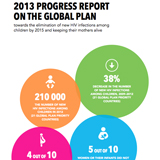
The Global Plan towards the elimination of new HIV infections among children by 2015 and keeping their mothers alive (Global Plan) was launched in July 2011 at the United Nations General Assembly High Level Meeting on AIDS. This report presents the interim progress made by 20 countries in sub-Saharan Africa and some of the challenges they face in meeting the agreed targets for 2015. Of the 22 Global Plan priority countries, data from India were not available at the time this report was written. Only provisional data were available from Uganda at the time of publication. The preliminary results for
Uganda are included in the aggregated values, but no country-specific data are presented here.
Antiretroviral therapy coverage among pregnant women living with HIV has increased but remains low
The number of pregnant women living with HIV receiving antiretroviral therapy for their own health has increased since 2009. In Botswana, Ghana, Malawi, Namibia,
Malawi, with its policy of providing antiretroviral therapy to all pregnant and breastfeeding women (irrespective of CD4 count), increased the coverage of women from 13% in 2009 to 86% in 2012. Malawi has been able to increase antiretroviral
The number of women becoming newly infected with HIV between 2009 and 2012 remains stable in most of the 20 countries. Only Ghana (44%) and South Africa (28%) have substantial declines in the number of women acquiring HIV infection.
The lack of decrease in new HIV infections among women in most of the priority
Reducing unmet need for family planning will reduce new HIV infections among children and improve maternal health. Increasing access to voluntary and noncoercive family planning services for all women, including women living with HIV, can avoid unintended pregnancies. Family planning enables women to choose
Percentage of eligible pregnant women living with HIV receiving antiretroviral therapy for their own health, 2012 the number and spacing of their children, thereby improving their health and wellbeing. Coercion for family planning and forced sterilization of women living with HIV are completely unacceptable under any circumstances and violations of human rights.